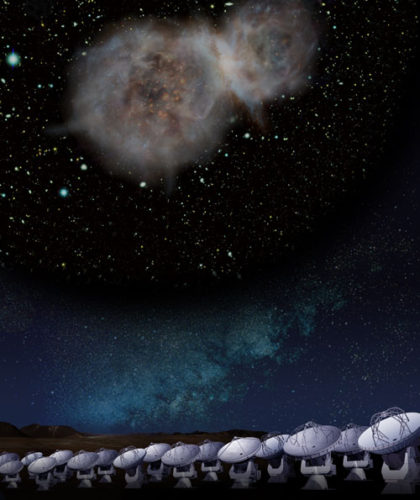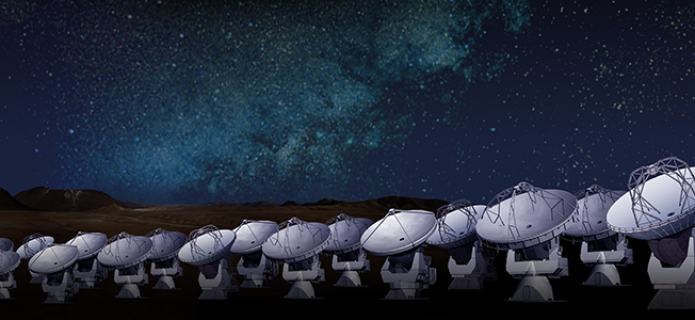ALMA Reveals Constituent of a Galaxy 12.4 Billion Light-Years Away
An international team composed of researchers from Japan and Europe has observed a "sub-millimeter galaxy" located about 12.4 billion light-years away from Earth using the Atacama Large Millimeter/submillimeter Array (ALMA).
Comparisons between the data obtained by ALMA and numerical models revealed that the elemental composition of this galaxy in the early Universe, at only 1.3 billion years after the Big Bang, was already close to the elemental composition of the present universe. This result suggests that intense star formation activities had occurred in the early Universe.
ALMA is an international astronomy facility located 40 kilometers away from San Pedro de Atacama and at an altitude of 5,000 meters in northern Chile, specifically on the Chajnantor plateau. ALMA is a partnership of Europe, North America and East Asia in cooperation with the Republic of Chile. Although it still is under construction, and operating at just a quarter of its capacity, it has already started the Early Science observation process. When completed at the end of next year, ALMA will be the largest astronomical project in existence: a single telescope with a revolutionary design composed of 66 high-precision antennas.
Using ALMA, this international research team has successfully detected an emission line from nitrogen contained in the "sub-millimeter galaxy”. "At first, I thought this observation would be very hard,” said project leader Tohru Nagao, Associate Professor at the Hakubi Center for Advanced Research at Kyoto University. Nagao added: “The strength originally expected of the nitrogen emission line was very weak. So I was very excited to find a clear nitrogen emission line. The power of ALMA is overwhelming."
A submillimeter galaxy is a type of galaxy that has intense star formation activity but is covered by large amounts of dust that block visible light. This situation hampers detailed observation of the galaxy with optical telescopes. ALMA observes celestial objects at millimeter wavelength, penetrating dust clouds. In addition, ALMA also has extraordinary sensitivity, which can catch even extremely faint radio signals. This is the result with one the most distant galaxies ALMA has ever observed.
This research will be published in the "Letters" section of the European astronomy journal Astronomy & Astrophysics.
Links:
Research Paper
NAOJ website for more information regarding this research
Contacts:
Tohru Nagao
Associate Professor at the Hakubi Center for Advanced Research at Kyoto University
Tel: +81 75 753 3691
Email: [email protected]
Masaaki Hiramatsu
Education and Public Outreach Officer, NAOJ Chile Observatory
Tokio, Japan
Tel: +81 422 34 3630
E-mail: [email protected]
William Garnier
Education and Public Outreach Officer, Joint ALMA Observatory
Santiago, Chile
Tel: +56 2 467 6119
Email: [email protected]
Douglas Pierce-Price
Public Information Officer at ESO
Garching, Germany
Tel: +49 89 3200 6759
Email: [email protected]
John Stoke
Assistant Director - Education & Public Outreach
National Radio Astronomy Observatory
Charlottesville VA, EE.UU.
Tel: +1 434 244 6896
Email: [email protected]

Artist's impression of the submillimeter galaxy LESS J0332 observed by ALMA on the 5000-meter altitude plateau. During this project, 18 antennas were used for the observations, and a total of 66 antennas will have been installed when ALMA is completed.
Credit: NAOJ

